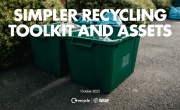China publishes five-year plastics pollution plan
China published last Wednesday (15 September) a five-year plan outlining the nation’s strategy for tackling plastics pollution.
The plan will see China’s recycling capacity expanded, alongside the promotion of ‘green’ plastic products. The plan also presents commitments to combat the overuse of plastics within the agriculture and packaging sectors. Additionally, and more contentiously, an increase in incineration volume is outlined.
 In terms of combatting the overuse of plastics, the proposed plans will see a nationwide ban being imposed on the production of ultra-thin plastic bags, as well as on personal care products that contain plastic microbeads – these are currently already banned in the United States and much of Europe. The plans will also attempt to advance the recycling rates of agricultural plastic mulch to 85 per cent, as the residues of the film material, which is typically used to conserve moisture and heat throughout China’s northern regions, have the potential to contaminate crops and reduce soil fertility. In tandem with reducing the usage of these plastics, the plan proposes that the Chinese government commits to advocating the use of alternative products such as bamboo, wood, paper, and biodegradable plastics.
In terms of combatting the overuse of plastics, the proposed plans will see a nationwide ban being imposed on the production of ultra-thin plastic bags, as well as on personal care products that contain plastic microbeads – these are currently already banned in the United States and much of Europe. The plans will also attempt to advance the recycling rates of agricultural plastic mulch to 85 per cent, as the residues of the film material, which is typically used to conserve moisture and heat throughout China’s northern regions, have the potential to contaminate crops and reduce soil fertility. In tandem with reducing the usage of these plastics, the plan proposes that the Chinese government commits to advocating the use of alternative products such as bamboo, wood, paper, and biodegradable plastics.
As for the proposed increase in incineration capacity, urban incineration targets are to be set at 800,000 tonnes per day by 2025, according to the agenda – this would be an increase from 580,000 tonnes last year. Whilst the intention is that incinerators will divert plastic waste from polluting the environment, in particular aquatic and marine biomes, some would state that an increased incineration capacity also equates to an increased emissions capacity. Critics of incineration would also point out that many incinerators require plastic waste to be separated from the input material, in fact, in order to reduce the release of toxic gasses. So, in spite of the proposed expansion of China’s combustion competency having the power to reduce the amount of plastic waste that ends up as litter, there is the contentious issue of an enlarged greenhouse gas (GHG) output.
As a nation that produces over 60 million tonnes of plastic annually, yet holds a recycling rate of just 30 per cent, The National Development and Reform Commission (NDRC) stated in a notice that China was obligated to improve ‘the entire chain of plastic pollution control’. Attempts are already being made by the Chinese government, however, in order to tackle the issue of plastic waste. Major cities are being encouraged to introduce initiatives such as refuse sorting policies; the construction of industrial-scale recycling plants; and the banning of single-use products, such as plastic straws and shopping bags, from being distributed by restaurants and e-commerce platforms. A solid waste law also came into effect last year, which saw fines for those illegally importing solid waste being raised tenfold, as well as the construction of modern recycling infrastructure being mandated.
An NDRC spokesperson commented: "The essence of plastic pollution is that plastic waste leaks into natural environments like soil and water and is hard to degrade, causing visual pollution, soil damage, microplastics and other environmental hazards.”






